Posted by Cameron on 12.16.08 1:46 PM
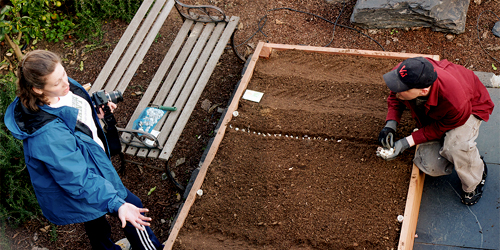
I have never been an instinctively organized person. I tend to leave planning until the last minute, overestimate (and overbuy) the necessary materials, and then fly by the seat of my pants. Most of the time my “method” works, but it can be wasteful. It’s also hard to define and evaluate what I did in retrospect, so that I can do it better next time.
I have been trying like heck not to take my typical approach with our nascent vegetable garden. From the construction of our new raised beds (hammer and shovel account coming in a future post, I promise) to planning plantings, I have actively encouraged my inner project manager to come out and play.
However, I am acutely aware of the fact that what I consider a “plan” often sounds like Marty McFly’s instructions to the 1950s dance band in Back to the Future: “Okay guys, this is a blues riff in B. Watch me for changes and try and keep up, okay?” So when Genie, aka the Inadvertent Gardener, volunteered to lend a hand with our very first planting, I was primed to overthink the entire event. And boy, did I.
I read all of the instructions on the seed packets, inside and out, cross-referencing the information with my two new best friends, Pam Peirce’s Golden Gate Gardening and Jeff Ball’s 60-Minute Vegetable Garden. I gazed at our new beds, making calculations about relative amounts of sun and shade, and searched the Web for general planting instructions, raised bed ideas, and wide-row planting theory. I made a list of the vegetables that I wanted to grow, organized by the distance between rows that each required. I drew up a small diagram of my beds (to scale, of course), illustrating what would go where. And, when Genie asked what time she should arrive on Saturday, I thought about how much time planting might take and left a generous margin for error, suggesting that I pick her up from the BART station at 1pm.
Saturday morning, I laid out all of my garden tools (a shovel, a long rake, a hand trowel, and a hand rake) and the seed packets, clipped together. It wasn’t until Genie arrived and I started describing the work plan — illustrated with my hyperactive little meth-junkie diagram — that I started hearing the loose screws rattling around in my tiny little head. I hauled in the reins and ground to a halt, biting off the suggestion that we measure the distance between rows. Folks, we’re talking about two small raised beds, each almost exactly eight feet long and four feet wide; surrounded by and aligned with stone tiles that are each almost exactly two feet square. About the only thing that we didn’t have to work with was a grid printed directly on the dirt. Somewhat sheepishly, I handed Genie a rake and suggested that we start loosening the soil in the beds, which had settled and crusted over a bit in the two weeks since I installed them.
About an hour later, I was feeling like an even bigger dork. The planting that I thought would take most of the afternoon? Done. Actually, Genie finished her bed in about 30 minutes and spent the rest of the time taking pictures of me stumbling about. Right now, somewhere, my über-gardener mom is looking down on me and laughing her butt off. With love, sure. But laughing nonetheless.
But you know what? We now have a bunch of dirt with seeds in it! We’ve got three kinds of onions in (two from seed and one from sets) — some that I’m planning to pull as scallions. We also planted three rows of mixed beets, two rows of French breakfast radishes and another of cherry radishes, a row of leeks, two of peas, and one of mixed lettuce.
And to tell the truth, I could use more “chore” days like this one. Anita made delicious lunch of Reuben sandwiches with Marin Sun Farms pastrami, which we ate with Laura’s dilly beans and Sean’s pickles. We spent the rest of the afternoon talking, playing with the pups, sipping beer, and kibitzing in the kitchen.
After the sun went down, the three of us washed our faces, put on our city duds, and headed off to SPQR, where red wine, non-stop wisecracks, at least six different kinds of pork, and a surprise fireworks display (seen across the bay from the top of Fillmore Street as we waited for our table) were the order of the evening. If there’s a better, happier, more karmically charged way to kick off a new garden, I cannot imagine what it would be.



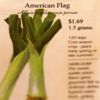

garden, other blogs
11 Comments »




Posted by Anita on 12.15.08 10:54 PM
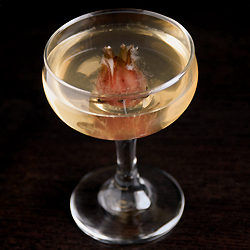 When Sean and DPaul asked me to contribute a signature cocktail to serve with the appetizer course at their holiday soirée last weekend, I kept running into dead ends. For my previous stint behind the Hedonia bar, I’d whipped up a pair of well-received drinks, but for the holidays I wanted to try something a little more classically festive — and what’s more festive than bubbly?
When Sean and DPaul asked me to contribute a signature cocktail to serve with the appetizer course at their holiday soirée last weekend, I kept running into dead ends. For my previous stint behind the Hedonia bar, I’d whipped up a pair of well-received drinks, but for the holidays I wanted to try something a little more classically festive — and what’s more festive than bubbly?
But, if you know those Hedonia boys, you know that their parties are a feast for the eyes as well as the palate; a simple Champagne cocktail — classic though it may be — would not do. No, I needed a conversation starter, a ‘wow’ of a drink that would be sure to set off the beautiful hors d’oeuvres. I toyed with a number of ideas, but kept coming back to the idea of poinsettias and other holiday flowers. Then, while digging through the liquor cabinet, I noticed a jar of candied hibiscus flowers: pretty, festive, and a perfect holiday red.
The purveyor of these little antipodean garnishes suggests dropping one blossom into a flute of bubbly, with or without a splash of its syrup. But even before I remembered Craig‘s choice for this month’s Mixology Monday theme, I knew that I wanted to avoid fruity flavors and move things more into the spice realm.
At first, I tried a simple Champagne and Ginger cocktail, using Domaine de Canton ginger liqueur. Although sweet and pleasant, it really didn’t have the oomph I was looking for. A few hearty dashes of super-spicy whiskey barrel-aged bitters helped a bit, but really didn’t carry the drink into fabulousness.
Then I remembered an experiment from two winters ago. In the days before Domain de Canton hit the shelves, I’d spent a few months trying different techniques to get a strong ginger flavor into a cocktail without using ginger beer, mostly unsuccessfully. But then a “so simple it couldn’t work” idea paid off, and I ended up with a batch of spicy, faintly sweet infusion with a true ginger flavor. A repeat batch of this crystallized ginger digestif turned out to be just the thing to make my holiday sparkler shine.
But back to the garnish: I sampled some of the syrup the blossoms were preserved in, so I had a good handle on their flavor. However, the jar of flowers only held 11 blossoms and I had 10 guests to serve, so I hoarded them all for party night. Little did I know that, instead of the pretty little flowers shown in all the marketing shots, the blooms would become translucent red aliens in the cocktail glass, wicked half-plant/half-animal mutants straight out of a sci-fi movie.
Luckily our hosts and friends were gracious enough to humor our cocktail folly; only one guest refused (vehemently, I might add) to sample the flower, which does indeed taste like a sweet-tart berry. And once the bizarre garnish was gobbled up, everyone asked for refills on their spicy Champagne.
Looking through the photos that DPaul graciously sent over (I managed to bring my camera, but forgot the memory card), I realized that the hibiscus blossom looks like the head of a snake, or a sandworm from the movie version of Dune… a story that’s — appropriately enough — all about spice.

Shai Hulud
1 oz homemade ginger liqueur
– or 1 oz Domaine de Canton plus 1/2 tsp ginger juice
5 dashes Fee Brothers Whiskey Barrel-Aged bitters
Champagne or other dry sparkling wine
candied hibiscus flowers
Measure the ginger liqueur and bitters into a coupe. Top with bubbly and garnish with a hibiscus flower.
Ginger Liqueur
3 oz crystallized ginger chunks
– available in the baking aisle or bulk foods stores
8 oz 80-proof vodka
Combine in a lidded jar. Let steep for two days, then shake; you should notice dark, syrupy threads diluting into the vodka. Continue to steep, shaking once a day, until you reach your desired level of spiciness.
drinks, Mixology Monday, recipes
8 Comments »




Posted by Anita on 12.15.08 7:00 AM
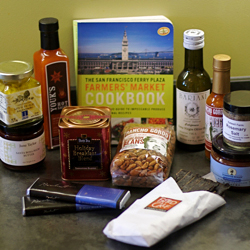 For two weeks every December, bloggers from all over the world offer a delectable array of food-related prizes for the Menu for Hope raffle. Last year, we raised $85,493 to help the UN World Food Programme feed the hungry. This year’s campaign runs December 15 to 25, and every $10 you donate earns you one virtual raffle ticket for the prize of your choice.
For two weeks every December, bloggers from all over the world offer a delectable array of food-related prizes for the Menu for Hope raffle. Last year, we raised $85,493 to help the UN World Food Programme feed the hungry. This year’s campaign runs December 15 to 25, and every $10 you donate earns you one virtual raffle ticket for the prize of your choice.
(To learn more, head over to Chez Pim and check out her Menu for Hope V FAQ, or read the highlights at the bottom of this post.)
This year, we’ve decided to reprise our most-popular offering from last year’s raffle:
Married …with Dinner’s signature “Best of the Ferry Building” gift basket
Prize code UW-07, a hand-picked assortment of our favorite treats — worth more than $125 — from San Francisco’s legendary Ferry Building Marketplace:
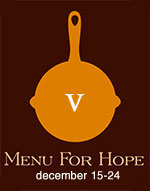 – Truffled artichoke tapenade from Lulu Petite
– Truffled artichoke tapenade from Lulu Petite
– Santa Rosa plum preserves from June Taylor
– Youk’s Sauce from Prather Ranch
– Holiday Breakfast Blend tea from Peet’s
– A pair of artisan “dark milk chocolate” bars from Recchiuti
– Ojo de Tigre beans from Rancho Gordo
– Rio Fuego “Very Hot Sauce” from Rancho Gordo
– Extra-virgin olive oil from Bariani
– Rosemary salt from Eatwell Farm
– Bittersweet chocolate ganache from Scharffen Berger
– Beef jerky from Fatted Calf Charcuterie
– A copy of the Ferry Plaza Farmers Market Cookbook
To give you something to remember us by when all the goodies are gone, this prize also includes the winner’s choice of an 8×10 print from our collection of market photos.
For our prize, international bids are welcome, but winners outside the Continental US will be asked to pay for any import duties and/or shipping fees over US$25.
—-
Here’s how to donate and get a chance to win:
- Check out the cool items available on Matt*Bites and Chez Pim. (We know you want to win OUR prize, but you might want to bid on others, too …you generous foodie, you.)
- Go to the donation page for Menu for Hope V. Just like last year, funds raised will go to support the United Nations World Food Programme.
- Make a donation! Each $10 you donate will give you one virtual raffle ticket toward a prize of your choice. Please specify which prize or prizes you’d like in the “Personal Message” section in the donation form when confirming your donation
- Don’t forget to mention how many tickets you want to allot per prize, and please use the prize code — for example, a donation of $50 can buy 1 ticket for UW-07, 1 for UW-08, and 3 for UW-09.
- If your company matches your charity donations, please remember to check the appropriate box on your submission and fill in the information so Menu for Hope can claim the corporate match.
- Please also check the box that allows the contest administrators to see your email address so that they can contact you in case you win. Your email address will not be shared with anyone else.
- Check back on Chez Pim on January 12, when Pim will announce the result of the entire raffle. (We’ll also announce the winner of our prize here.)
Good luck to everyone, and thanks for supporting such a worthy cause!
Menu for Hope
3 Comments »




Posted by Anita on 12.14.08 10:39 AM
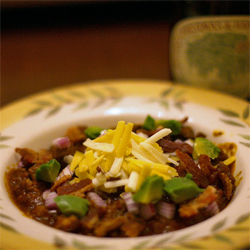 Between finishing up our Christmas shopping, getting our prize basket ready for Menu for Hope V, dealing with a rather scary veterinary emergency, and nailing down a few last details for our upcoming vacation, things have been a little chaotic around here. This morning as I sat down to write, I looked up in panic and realized that I had only photographed a single meal this week.
Between finishing up our Christmas shopping, getting our prize basket ready for Menu for Hope V, dealing with a rather scary veterinary emergency, and nailing down a few last details for our upcoming vacation, things have been a little chaotic around here. This morning as I sat down to write, I looked up in panic and realized that I had only photographed a single meal this week.
Luckily, it was our favorite chili, which — even though we eat it pretty much all the time — I’ve never blogged about. We love it because, unlike other chili recipes that we’ve been known to make, this one’s highly adaptable. Like our bolognese sauce and sloppy joes, it’s another one of the recipes that we make in giant batches and freeze for weeknight dinners. If we’re using it to make chilidogs — which we often do — we’ll leave the beans out and simmer it down until it’s all meaty and thick. If we’re eating it on its own, we’ll add some Rancho Gordo beans, and thin it down a little with a few cubes of frozen chicken stock.
We almost always garnish it with cheese, sour cream, and chopped onions, but if you happen to be lucky enough to have a strip of crispy bacon or a late-season avocado lurking in your fridge, either one makes a tasty and pretty addition. But this chili’s equally delicious when served all on its own, preferably with a pan of homemade cornbread and sweet butter. (We just discovered that Giustos, the local outfit that makes the all-purpose flour we buy, also sells locally milled cornmeal and polenta, which increases our Dark Days meal options significantly.)
 Adaptable Chili
Adaptable Chili
– loosely inspired by ‘Venison Chile with Red Beans’
from Staff Meals at Chanterelle
3 pounds stew meat, cut into 1/2-in inch cubes
(or substitute coarse-ground beef)
1 medium onion, diced
2 large cloves garlic, minces
1 tsp ground ancho chile
1 tsp ground pasilla chile
1 tsp Rancho Gordo ground red chile
1 tsp ground cumin
1 tsp ground cinnamon
1 tsp cayenne pepper
1/2 tsp black pepper
1/2 tsp dried thyme
1/2 tsp dried oregano
1/2 tsp cocoa powder
2 bay leaves
4 cups chicken stock or unsalted broth
1/2 cup tomato puree
2 cups cooked heirloom beans, drained (see note)
shredded cheese, sour cream, chopped onion, bacon, and/or diced avocado, for garnish
Pour vegetable oil to a depth of 1/8 inch into a large heavy Dutch oven set over medium-high heat. When the oil just begins to smoke, add only enough meat to cover the bottom of the pan without crowding. Brown well on all sides, turning with tongs. As the pieces brown, transfer to a bowl and continue with more meat in batches.
When meat is all browned, reduce heat to medium-low. Drain the accumulated oil from the bowl back into the pan; add the onion and garlic, and sweat until transluscent. Return the browned meat to the pan, then add the chile powders and spices. Stir well to coat the mat, then add the stock, tomato, and salt to taste. Bring to a boil, then reduce heat to low and simmer, uncovered, until the meat is tender — 2 to 2-1/2 hours — stirring occasionally. Stir in the beans, if using, and cook until heated through, about 5 minutes. Taste and adjust seasonings.
Note: If freezing for later use, the chili takes up less space without the beans, which you can always add the night you plan to serve it.
Dark Days challenge, locavore, recipes
8 Comments »




Posted by Anita on 12.07.08 2:26 PM
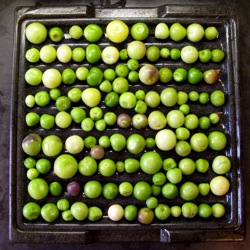 Last weekend, I went through both freezers — the little one in the kitchen, and the slightly larger one in the garage — and inventoried their contents. I didn’t discover any huge surprises in either location, thankfully, but I did turn up a few odds and ends that would be better to eat now rather than later. And since we needed to make room for half a turkey’s worth of meat, a little reorganization was in order.
Last weekend, I went through both freezers — the little one in the kitchen, and the slightly larger one in the garage — and inventoried their contents. I didn’t discover any huge surprises in either location, thankfully, but I did turn up a few odds and ends that would be better to eat now rather than later. And since we needed to make room for half a turkey’s worth of meat, a little reorganization was in order.
In addition to the pickles and broth I put up last weekend, I also made a big batch of tomatillo-sauce base to freeze: I roast and puree chiles and tomatillos, then add onions and simmer it down. Right before I’d usually add poultry broth and re-reduce to make a sauce, I cool down the paste and portion it out for the freezer. When I want to make enchiladas or chile verde, I thaw a brick, add the missing liquid, and finish the recipe.
 The two big Dark Days meals we cooked at home took care of some freezer odds and ends, and used the last of the un-frozen Thanksgiving leftovers, too. On Monday night, we whipped up a batch of our favorite stacked enchiladas with a little of the tomatillo sauce I’d set aside, along with a half-packet of tortillas and container of Rancho Gordo beans from the freezer, and the last bits of meat left over from turkey sandwiches. Later in the week, Cameron made a delicious beef-and-ale stew using a pound of Marin Sun chuck we’d stashed away from an early CSA box. Topped with the last of the Thanksgiving mashed potatoes, the stewmade a very decadent sort of cottage pie.
The two big Dark Days meals we cooked at home took care of some freezer odds and ends, and used the last of the un-frozen Thanksgiving leftovers, too. On Monday night, we whipped up a batch of our favorite stacked enchiladas with a little of the tomatillo sauce I’d set aside, along with a half-packet of tortillas and container of Rancho Gordo beans from the freezer, and the last bits of meat left over from turkey sandwiches. Later in the week, Cameron made a delicious beef-and-ale stew using a pound of Marin Sun chuck we’d stashed away from an early CSA box. Topped with the last of the Thanksgiving mashed potatoes, the stewmade a very decadent sort of cottage pie.
We spent some time this weekend getting the garden ready for fall, pruning the fruit trees and cutting back the hardy herbs like rosemary. I ended up with enough cuttings to make a few rustic wreathes. Contrary to my romantic notions, wreath-making can be a messy, sticky job (your hands end up covered in a pine-like sap!) but I think the end result was worth it. I now have pretty holiday decorations with a lovely scent, and afterward the sprigs can be stripped to use in cooking.
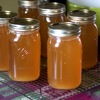
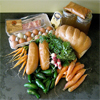


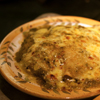
Where’s the recipe??
We’re experiencing some technical difficulties — our blog server is running painfully slow, and it was all we could manage to get this post up in time for the Dark Days roundup before running off to not one but two holiday parties this evening. If you’re interested in Cameron’s recipe for the Beef Braised in Ale, check back early next week.
Beef in Ale
– adapted from The River Cottage Meat Book
3# boneless chuck or stewing beef, trimmed and cut into 2-inch chunks
8 ounces pancetta or bacon, cut into 1-inch pieces
2 T butter or drippings
1 pound of onions (Hugh specifies baby onions, peeled and left whole. I used medium-sized yellow onions, quartered)
Up to 1/3 c all-purpose flour, seasoned with salt and pepper
4 cups ale (Hugh calls for stout)
2 bay leaves
1 sprig thyme
A few stems of parsley
8 ounces each of carrots and celery, cut into chunks
Heat the butter or drippings in a Dutch oven or other large stew pot and render the pancetta or bacon over medium heat, cooking until well-browned. Remove the bacon with tongs or slotted spoon and reserve on a plate. Fry the onions in the hot fat until they are lightly browned all over. Remove the onions and add to the bacon on the reserve plate. Turn up the heat to medium-high or high depending on your stove. Toss the beef in the seasoned flour and shake/pat off as much of the excess as possible, leaving only a fine layer of flour behind.
Working in batches, thoroughly brown the beef on all sides, removing it to the reserve plate when you dare not leave it in any longer. Here is where your diligence in flour removal will pay off. The browner you can make the beef chunks, the better your stew will taste, but extra flour will flake off and burn before you can get the beef where you want it.
Pour in some of the ale and deglaze the pot, scraping up the browned bits with a wooden spoon. Tip the contents of the reserve plate (bacon, onion, beef, and any juices that have collected) into the pot. Pour in the rest of the ale, adding water if necessary to just cover the meat. Add the herbs, tied into a bouquet garni. Taste and season lightly with salt and pepper, keeping in mind the saltiness of your bacon and the fact that you will be reducing the liquid. Bring to a boil and set to simmer gently with the lid on but slightly ajar.
The stew will need to cook roughly 2-1/2 hours. This can be done either on the stovetop or in an oven set to 250° F. If the meat starts to get exposed, add a little hot water. Approximately one hour before you expect the meat to be done, add the carrots and celery. You’ll know it’s done when the meat falls apart at the touch of a fork.
Remove the bouquet garni. Taste again for seasoning and serve under, over, beside, or puddled in potatoes that have been mashed with scandalous amounts of cream and butter.
Dark Days challenge, garden, locavore, recipes
8 Comments »




Posted by Anita on 12.06.08 9:03 AM
 When Cameron and I started blogging a few years ago, we were talking to ourselves. After walking away from the food message boards that had been our online home, we found ourselves adrift. A pair of food-obsessed writers can’t exist in a vacuum for long, so when our pal Sean suggested we should blog, it didn’t take us long to see the wisdom of his plan. We set up an account, bought a domain, and started writing.
When Cameron and I started blogging a few years ago, we were talking to ourselves. After walking away from the food message boards that had been our online home, we found ourselves adrift. A pair of food-obsessed writers can’t exist in a vacuum for long, so when our pal Sean suggested we should blog, it didn’t take us long to see the wisdom of his plan. We set up an account, bought a domain, and started writing.
An interesting thing happened along the way: People — strangers who we didn’t even know! — started reading the blog. Some of them even left us comments. And then we started visiting their blogs, leaving comments, and becoming intertwined with their lives. We celebrated their joys, cheered on their triumphs, cried at their losses, and consoled them in their grief… and they did the same for us. It’s funny to say this about people who I’ve (mostly) never met in person, but I’m closer with some of my food-blog pals than I am with people I see every day. To an outsider, perhaps this sounds odd, even a little loney… but to me, it’s one of the big blessings in my life, this circle of support and affection that literally crosses the oceans.
The most fabulous things happen in this little world of ours. Last week, I got an email from Bron, telling me that she and Ilva were planning a big surprise for our mutual friend Barbara, who’s been struggling with the side-effects of chemotherapy. Would I help them send a virtual hug to Barbara this weekend, in the form of a recipe? Oh, absolutely!
To me, nothing says love and comfort better than a bowl of soup. I know that bowl full of beef and chile sounds far too spicy and rich for someone struggling with the nausea and unpleasantness of chemo, but in truth this dish is clean, light, and flavorful, with just a hint of sweet spice. The broth base is chicken, not beef, so the flavors of the sprouts and scallions come singing through. Ginger is known to help with nausea, and if you seed the Fresno chile — which is already mild — you’re left with just the clean, fruity flavor and none of the heat. And because the meat is cooked separately and then used as a topping, you can adjust portions for varying appetites. Barbara doesn’t enjoy the taste of cilantro, so we substituted a sprig of flat-leaf parsley for the garnish; it’s mostly just for a splash of color, so feel free to leave it out entirely.
So here’s a hug to Barbara, across the oceans and miles. I wish we could come by and bring you a bowl of soup in person, but for now we’ll slurp a bowl of gingery noodles and keep you in our hearts.


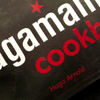
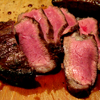
 Ginger Beef Ramen
Ginger Beef Ramen
– adapted from The Wagamama Cookbook
5 oz (150g) mung bean sprouts
9 oz (250g) ramen noodles
12 oz (350g) sirloin steak, 3/4-inch thick
teriyaki or soy sauce, for brushing
4 cups (1l) chicken stock
2T ginger, peeled and slivered, or more to taste
2T ramen sauce (recipe follows), plus more for serving
3 scallions, trimmed and sliced on the diagonal
1 red Fresno chile, trimmed, seeded, and sliced lengthwise
1/2 small red onion, sliced very thin
1 lime, quartered
parsley (or cilantro) sprigs for garnish
Rinse the steak and pat dry. Season with salt and brush with oil; let sit 30 minutes to come to room temperature.
Cook the noodles in a medium pot of boiling water until al dente, about 2 minutes. (I recommend cooking 1 minute less than the package indicates, as the hot soup will continue to cook the noodles later.) Drain and rinse with cold water until cool; drain well and set aside. In the same pot, heat the stock to a simmer; reduce heat to low and cover until ready to use.
Grill, broil, or pan-sear the steak until medium rare. Remove from the heat and immediately brush with teriyaki or soy sauce. Keep warm to rest for at least 5 minutes.
Add slivered ginger and 2T of ramen sauce to the stock, and heat to a rapid simmer; adjust for saltiness with soy sauce or fish sauce, as desired. Meanwhile, divide the noodles among two bowls, and slice the rested steak on the bias. Top the noodles with the beef, sprouts, scallions, chile slivers, onion. Garnish with herb sprigs and serve with lime wedges and additional sauce to add at the table.
Ramen Sauce
1 scant tsp sugar
1T malt vinegar
3T Asian sweet chile sauce (or to taste)
3T fish sauce
Dissolve the sugar in the vinegar, then combine with other ingredients.
cooking, other blogs, recipes
14 Comments »




Posted by Anita on 11.30.08 11:26 AM
 Apparently, I am not equipped to exist on 5 hours of sleep every night for an entire month, which is what happens when you try to hold down a job, tackle a little freelance work, keep a house in order, cook most meals at home, and blog every single night. But even though I failed at NaBloPoMo, I really did have a blast trying to keep my head above water. Despite the blog-silence, our week has been filled with all kinds of wonderful things to eat and drink… fodder for future posts, I promise, as we return to a slightly saner schedule in December.
Apparently, I am not equipped to exist on 5 hours of sleep every night for an entire month, which is what happens when you try to hold down a job, tackle a little freelance work, keep a house in order, cook most meals at home, and blog every single night. But even though I failed at NaBloPoMo, I really did have a blast trying to keep my head above water. Despite the blog-silence, our week has been filled with all kinds of wonderful things to eat and drink… fodder for future posts, I promise, as we return to a slightly saner schedule in December.
The highlight of our week — like many of yours, I suspect — was our big Thursday feast for Thanksgiving. This year, we managed to wiggle out of all of our family obligations, so it was just the two of us: No marshmallow-topped baked yams or gelatinous cranberry sauce (nor any of the other stuff neither of us likes) and no giant spreadsheet to track food miles. We still ate 100% local, but with a much smaller, simpler menu, we didn’t need to document with such precision.
I picked up our turkey — a burlap-wrapped 18-pounder from Napa’s Hudson Ranch, sold to us by Tayor at the Fatted Calf — at the Tuesday Berkeley Farmers Market. This squat little guy was so muscular we didn’t even need to truss the legs to keep them tight against the carcass. Although all we did was salt it the night before and slather it in butter, describing its taste sounds like a cliché: Moist and tender, yet full of deep poultry flavor. And the rich drippings made some of the most delicious gravy we’ve ever had.
 To go with the amazing turkey and gravy, we peeled and mashed many pounds of creamy La Ratte spuds from Mr. Little, mixed with butter from Spring Hill and Straus Family cream. Stuffing was the usual family recipe, with Fatted Calf bacon, Eatwell celery and parsley, Catalán onions, Acme bread, and our own home-grown sage and home-made chicken stock. There was corn from The Peach Farm — which I zipped and froze a few weeks back — and a bottle of Five Russians Pinot Noir from Sonoma. For dessert: Pumpkin pie made from local organic pumpkin, eggs, and dairy, in a crust of local flour (a blend of Eatwell and Giusto’s), Clover Organic butter, and Prather leaf-lard.
To go with the amazing turkey and gravy, we peeled and mashed many pounds of creamy La Ratte spuds from Mr. Little, mixed with butter from Spring Hill and Straus Family cream. Stuffing was the usual family recipe, with Fatted Calf bacon, Eatwell celery and parsley, Catalán onions, Acme bread, and our own home-grown sage and home-made chicken stock. There was corn from The Peach Farm — which I zipped and froze a few weeks back — and a bottle of Five Russians Pinot Noir from Sonoma. For dessert: Pumpkin pie made from local organic pumpkin, eggs, and dairy, in a crust of local flour (a blend of Eatwell and Giusto’s), Clover Organic butter, and Prather leaf-lard.
With only two of us to tackle a family-sized turkey, we cut off a whole breast, leg, and thigh, and vacuum-sealed them for the freezer; somewhere down the line there’s another round of turkey dinner (and leftovers!) in our future… what a way to stock up for winter!
The rest of our luxurious long weekend, we’ve spent tackling other Dark Days-related projects. Cameron’s been hard at work on building and filling our new raised beds, and we may even get a few starter crops in the ground before the new year. I’ve been pickling and preserving — a few quarts of chicken stock and turkey broth, some pickled jalapeños, and a batch of pub onions. After the canners were put away, I reorganized our freezers in preparation for laying down a few last supplies for the winter.
This week’s trip to the farmers market was pretty light, since we’ll mostly be eating an assortment of yummy bits and pieces from deep storage. Although a week of freezer fare may sound rather dreary, after four days of nonstop cooking and turkey leftovers, I’m really looking forward to a few meals where the hardest part is defrosting the main dish and making a big salad.
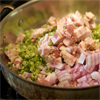


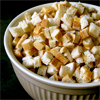

This year, I am especially thankful for:
– My wonderful husband, who takes care of me and our home with such obvious affection.
– Our family, who understand our need to take a break from the festivities now and then.
– Our social circle, whose hospitality and friendship keep us sane and happy.
– Our readers and blog pals, who encourage us and inspire us.
– Our amazing City, where we count ourselves lucky to live every day.
– Our region’s hard-working farmers and food artisans, who provide us with the world’s most amazing array of edibles.
Dark Days challenge, holidays & occasions, locavore, meat
6 Comments »




Posted by Anita on 11.23.08 11:55 PM
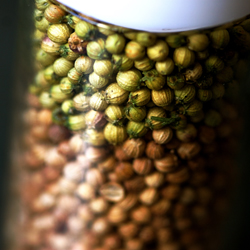 I was going to title this post “Last harvest”, but then I realized — even in our fairly seasonal garden — that our harvest never really ends. The lemon tree is ever-bearing, and is coming into its peak fruit-picking season. The bergamot is busting out all over; it dropped a fruit today — which is almost certainly hollow, but plenty good for making one of our favorite liqueurs.
I was going to title this post “Last harvest”, but then I realized — even in our fairly seasonal garden — that our harvest never really ends. The lemon tree is ever-bearing, and is coming into its peak fruit-picking season. The bergamot is busting out all over; it dropped a fruit today — which is almost certainly hollow, but plenty good for making one of our favorite liqueurs.
Our makrut (kaffir lime) tree is growing so large that it needs a fairly major pruning; when that happens, we’ll have enough aromatic leaves and fruit to supply a small Thai village. And although the lemon verbena is dying back to its canes, the plum tree has gone dormant, and the basil is long-since gone to seed, we’ll have most of our herbs — thyme, oregano, and sage — through the dark days.
Today we tackled two garden-related tasks: One in the kitchen, to put up a few bits of the 2008 season, and one at the lumber yard, to lay the ground work for 2009. Early in the day, I picked and sifted through piles of coriander and fennel seed, which I’d set aside a few weeks ago to dry. As you can see from the photo above, the color contrast between home-grown seeds — even when fully dry — and store-bought is fairly dramatic; the scent and flavor are even more astounding.
Later in the afternoon, we headed off to the suburbs in search of redwood decking. We’ve finally decided — after two years of avoiding reality — that our pretty patio is a luxury; even in our sunny ‘hood, we aren’t able to entertain outdoors more than a few times a year. So Cameron pulled out the gardening books, mapping out a plan to replace some of the slate pavers with raised garden beds. (I’m hoping he’ll pop by soon to tell you more about his construction plans and maybe even share his planting diagrams.)





Dark Days challenge, garden, locavore
7 Comments »




Posted by Anita on 11.22.08 9:53 PM

We finally got ourselves over to Alameda this afternoon to visit the Hangar One / St. George Spirits distillery. We’ve always managed to be out of town during their annual open house parties, but this year was different. For a $30 ticket, we got the chance to sip pretty much everything they make (though we limited ourselves to things we hadn’t already tried), including the seasonal Spiced Pear vodka. The best part, though, was getting up close with their gorgeous copper stills, one of my favorite photo subjects.
For an additional $10, we also got to sample the new Agua Azul, a 100% agave spirit that can’t technically be called tequila because it’s not made in Mexico. We loved all three expressions — rich cristal, smoky reposado, and mellow-but-not-boring añejo — but balked when we saw the $60, $80, and $120 price tags. (We’ll probably change our minds right as they sell out, just as we did with the Absinthe Verte last year… oh well.)
In addition to all the sippable samples, admission included copious top-notch munchies: June Taylor preserves, Boccalone salumi, El Huarache Loco antojitos, La Cocina sweets, and Recchiuti chocolates. We were impressed at the short lines for both the samples and the loos (thanks to a set of porta-potties ’round back of the distilling equipment), and plentiful water stations all throughout the warehouse. A DJ spun tunes, employees answered questions, and a shuttle swung by every hour to drop guests off at BART.
Sound like fun? Sign up for the newsletter to find out about next year’s open house and other special events throughout the year.
Hangar One / St. George Spirits
2601 Monarch Street
Alameda, CA 94501
510.769.1601
drinks, East Bay, locavore
3 Comments »




Posted by Anita on 11.21.08 11:14 PM
 I feel downright terrible that it’s taken me this long to tell you about the fabulous time we had last month in Seattle at Le Mixeur, the exclusive soirée organized by the Munat Bros, Ted & Charles. But in my defense, it’s taken me this long to figure out how to explain it without sounding like I’m bragging. Because, dear reader, saying Le Mixeur is a cocktail party is like calling the Titanic a boat: Technically accurate, but completely missing the point both in scale and impact.
I feel downright terrible that it’s taken me this long to tell you about the fabulous time we had last month in Seattle at Le Mixeur, the exclusive soirée organized by the Munat Bros, Ted & Charles. But in my defense, it’s taken me this long to figure out how to explain it without sounding like I’m bragging. Because, dear reader, saying Le Mixeur is a cocktail party is like calling the Titanic a boat: Technically accurate, but completely missing the point both in scale and impact.
We’d read about these fabulous shindigs, jealously drooling over tales of drinks created by some of the West Coast’s finest mixological masterminds. But somehow — despite having ingratiated ourselves to the Munats both at the Zig-Zag and at Tales of the Cocktail — we’d never managed to sync our travel plans to their social calendar. Eventually, we hit the jackpot, scoring an invite to Le Mixeur Cinq on a weekend when we had no other obligations; away we flew.
On our first night in Seattle, we dropped in on Keith Waldbauer skulking in his lair at Union, one of our all-time favorite Seattle dining spots. We’d read that Keith had contributed a recipe to the Mixeur menu, and we asked him to tell us about his inspiration for the drink that would be served to dozens — if not hundreds — of serious cocktailians the following night.
“Oh… you’re going to Le Mixeur?” he asked with a gleam in his eye. “You’ll have to tell me how my drink tastes. I just sent them a recipe and didn’t even try it.”
Was he pulling our leg? You never know with Waldbauer. No sir, you never know with a man like that.
The next night, we made our way to a warehouse loft in SoDo, in the ominously empty streets bathed in the blue glow of Qwest Field. After climbing flight after flight of stairs, our efforts were rewarded. The white-walled loft opened out and up and away, revealing a happy hubbub. Our eyes darted from walls hung with eclectic art to the oh-my-god-impressive bar in the corner, where professional mixologists and a few determined amateurs shook and poured for the flowing crowd. In an open mezzanine above, the DJ nodded and smiled as the beat kicked in; a belly dancer took the floor, gyrating for the loudly appreciative audience.
The bar was stacked deep and thick as folks studied the night’s menu and waited patiently. We quickly found Charles Munat, and weasled our way into a couple of drinks after what we later realized was a uniquely short interval. Happily, the crowd was full of plenty of friends, as well as many familiar faces from bars both near and far. And the gods of mixology obviously watch over fools and drunks, because Keith’s drink — a minty, gin-based, tall sour with a Chartreuse float, which he’d dubbed the Aristocrat Swizzle — was every bit as perfect as the setting.





Aristocrat Swizzle
– Keith Waldbauer
1-3/4 oz gin
3/4 oz lime juice
10 mint leaves
dash simple syrup
1 barspoon green Chartreuse
Muddle mint and syrup in a mixing glass. Add gin and lime juice, and shake with ice. Strain into an empty Collins glass, fill with crushed ice, and top with a Chartreuse float. Garnish with a sprig of mint.
bar culture, Drink of the Week, drinks, Seattle
2 Comments »

















 – Truffled artichoke tapenade from Lulu Petite
– Truffled artichoke tapenade from Lulu Petite Between finishing up our Christmas shopping, getting
Between finishing up our Christmas shopping, getting 






 When Cameron and I started blogging a few years ago, we were talking to ourselves. After walking away from the food message boards that had been our online home, we found ourselves adrift. A pair of food-obsessed writers can’t exist in a vacuum for long, so when our pal
When Cameron and I started blogging a few years ago, we were talking to ourselves. After walking away from the food message boards that had been our online home, we found ourselves adrift. A pair of food-obsessed writers can’t exist in a vacuum for long, so when our pal 



 Ginger Beef Ramen
Ginger Beef Ramen


















